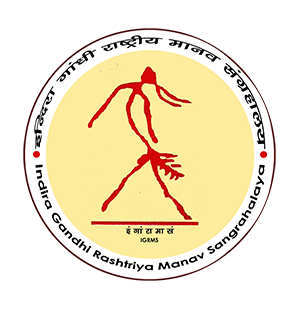जनजाति: सौवरा
क्षेत्र: गंजाम जिले उडिसा और श्री काकुलम
जिला: आंध्रा प्रदेश
संकलन वर्ष : 1988
ओडिशा की सावरा जनजाति का पारंपरिक आवास प्रकार
सावरा ओडिशा की सबसे प्राचीन जनजातियों में से एक है। सावरा यों तो पूरे राज्य में फैले हुए हैं पर उनकी आबादी का बड़ा हिस्सा गजपति और रायगडा जिले के गुनुपुर उप-मंडल में रहता है| उन्हें विभिन्न नामों से पुकारा जाता है जैसे सौरा, सौरा, सबारा, सावरा, सौर, सोरा आदि| यह भारत का प्रमुख आदिवासी समुदाय है जिसका अपना लंबा इतिहास है। इनका उल्लेख संस्कृत साहित्य, महाकाव्यों, पुराणों और अन्य धर्म ग्रंथों में मिलता है। विशेष रूप से ओडिशा में, वे भगवान जगन्नाथ की पूजा से बहुत घनिष्ठ रूप से जुड़े हुए हैं, जो एक पौराणिक परंपरा के अनुसार सावरा देवता के रूप में उत्पन्न हुए और बाद में शाही संरक्षण में पुरी लाए गए। सावरा पूर्वी भारत के ऊंचे दुर्गम स्थानो पर रहते हैं। वे मुख्य रूप से दो वर्गों, पहाड़ी सावरा या लांजिया सावरा और निचली भूमि सावरा या सुधा सावरा में विभाजित हैं। गांव पहाड़ी ढलानों पर दूर-दूर बसे हुए होते है | गांव के प्रवेश द्वार पर गांव देवताओं (काष्ठ स्तम्भ) की स्थापना होती है | आकर्षक भित्ति चित्र बनाते हैं, जिसे “इडितल” कहा जाता है| सामाजिक-धार्मिक रीति-रिवाज इनके सांस्कृतिक जीवन में सबसे अधिक महत्व रखते हैं। इनकी भाषा ऑस्ट्रो-एशियाई परिवार के कोल-मुंडा समूह से संबंधित है | सावरा मध्यम कद के होते हैं, महिलाएं पुरुषों से छोटे कद की होती हैं, इनके त्वचा का रंग हल्के पीले से गहरे-भूरे रंग का होता है | सिर पर घने लहरदार बाल होते है जो चेहरे पर कम होते है। सावरा गांव अपनी ऊँचे-ऊँचे पहाड़ों, तीक्ष्ण पर्वत धाराओं और ढलानयुक्त दूर-दूर घाटियों के साथ अपनी पोडु खेती के कारण बहुत सुरम्य होते है | पत्थरों द्वारा एक के ऊपर एक रचित सीढ़ीदार धान के खेत, पहाड़ियों और घाटी की सुंदरता को बढ़ाते है। सवरा सिंचाई में भी निपुण हैं | इन्होंने पहाड़ की धाराओं को बांधकर अपने सीढ़ीदार खेतों को सींचने के लिए पहाड़ी से नीचे पानी इकट्ठा करने में उल्लेखनीय कौशल दिखाया है। सावरा स्थानांतरित और स्थायी खेती में समान रूप से माहिर हैं। सावरा अपनी झोपड़ियों का निर्माण पहाड़ियों की तलहटी में या पहाड़ी ढलानों पर करते हैं|
अधिकांश सावरा गाँव घने जंगलों में होते हैं, और अजनबियों को अक्सर इन गाँवों में टेढ़े-मेढ़े जंगल के रास्तों का पता लगाना मुश्किल होता है। उनके घर अक्सर समानांतर पंक्तियों में होते हैं जो क्रमबद्धता को दर्शाते हैं। झोपड़ियाँ आयताकार होती हैं जिनकी दीवारें मिट्टी से बनी होती हैं और उन पर पत्थर बड़े करीने से मिट्टी से मढ़े जाते हैं जो अक्सर सफेद धारियों से सजाए जाते हैं। लिविंग रूम में फर्श से लगभग पांच फिर ऊपर गुणकार बीम द्वारा बनाई गई लाफ्ट पर अनाज टोकरियों में रखा जाता है | छत ढलानयुक्त और घास की छप्पर वाली होती है | छत की घास को दो-तीन साल में एक बार बदला जाता है । सावरा का मुख्य भोजन चावल, रागी या जाना या कुछ अन्य आनाज है। कभी-कभी वे आम के बीज, रागी और चावल की गिरी से तैयार जौ खाते हैं। मिट्टी के पत्रों में भोजन पकाते है और पत्तियों से निर्मित पात्रों में खाते हैं | ये शाकाहारी भोजन की तुलना में मांसाहारी भोजन अधिक पसंद करते है और इसके बिना कोई त्योहार नहीं मनाया जाता साथ ही किसी अतिथि का स्वागत मांसाहारी भोजन के बिना संभव नहीं है। सावरा ने अपने पंथ में कई देवी-देवताओं और उप-देवताओं को शामिल किया है | उनकी मूल विश्वास प्रणाली पूर्वजों और आत्माओं की पूजा के इर्द-गिर्द केंद्रित है। इन सभी देवताओं और आत्माओं की अपने अनुयाईयों से निरंतर अपेक्षा होती है। उनका मानना है कि अगर उनकी मांगें पूरी नहीं की गईं तो वे उन्हें नुकसान पहुंचा सकते हैं। इन सभी देवताओं और पूर्वजों की आत्माओं को संतुष्ट करने के लिए वे मुर्गी, बकरी, भेड़, सूअर, भैंस और शराब के बर्तन और कपड़े चढ़ाते हैं।
नृत्य सावरा जीवन का अभिन्न अंग है। ये स्त्री-पुरुष, सभी के मनोरंजन का महत्वपूर्ण स्रोत है। इनका कोई भी त्यौहार या समारोह नृत्य के बिना पूरा नहीं माना जाता है। सावरा द्वारा तीन प्रकार के प्रमुख नृत्य किए जाते हैं, ये हैं बागा बागुली, रसराकेली और दलखाई नृत्य। बागा-बगुली नृत्य सावरा के महत्वपूर्ण नृत्यों में से एक है। बागा-बगुली नृत्य अविवाहित लड़के और लड़कियों द्वारा ग्राम माँ या कुडनबोई के निर्देशन में किया जाता है। जब भी कोई अतिथि गांव में आता है तो उनके मनोरंजन के लिए प्रेम और सम्मान का प्रतीक ‘बागा-बगुली’ नृत्य का आयोजन किया जाता है। सावरा बहुत ही कलात्मक लोग हैं, उनका कौशल न केवल उनके भित्ती चित्रों में बल्कि उनके नृत्य और संगीत में भी प्रकट होता हैं। उनके गीतों के शब्द संयोजन में हास्य, रोमांस और माधुर्य का खूब समावेश होता है | संगीत ने उनके ग्रामीण जीवन में एक महत्वपूर्ण भूमिका निभाई है। संगीत उनके लिए मात्र नाच-गाने का विषय नहीं है बल्कि इसका संबंध मुख्य रूप से अनुष्ठान और शारीरिक एवं आध्यात्मिक कल्याण की परंपरा, रीति-रिवाजों, शादी विवाह और अन्य समारोहों के साथ वसंत से जुड़े अनुष्ठानों से भी है। वे विभिन्न प्रकार के वाद्ययंत्र बजाते हैं जैसे कि विभिन्न आकारों के ढोल, बांसुरी, पाइप, झांझ, शहनाई, घडि़याल, रस्सियां और तंतु वाद्ययंत्र। सावरा संस्कृति की विलक्षणता पूर्वजों की पूजा में है जिसे वे ‘दुंबा’ कहते हैं, जो इस विश्वास के साथ की जाती है की पूर्वज मृत्यु के बाद भी दुनिया में रह रहे हैं और अभी भी परिवार की भलाई के लिए उनकी देखभाल कर रहे हैं। वे सोचते हैं कि अपने सुख-दुख और सामाजिक कार्यों में पूर्वजों को भूलना पाप है। भारत की 2011 की जनगणना के अनुसार, ओडिशा में सावरा की जनसंख्या 5,34,751 है |
Tribe: Saora
Area: Ganjam, dist. Rict Orissa and Srikakulam Disin Andhra Pradesh
Year of collection:1988
Traditional House type of Saora Tribe of Odisha
The Saora’s are known as one of the oldest tribes in Odisha. Bulk of their population lives in Gajapati district and Gunupur sub-division of Rayagda district. They are also found in all the districts of the state. They are known from various names such as saora, saura, sabara, savara, saur, sora etc. They find mention in the Sanskrit literature, the epics, the puranas and other religions texts. Especially in Odisha, they have been very intimately connected with the worship of Lord Jagannath who according to a legendary tradition originated as a Sabara deity and was later brought to Puri under royal patronage. They live in the hilly and mountainous region of Eastern India. They are mainly divided into two classes Hill Saoras or Lanjia Saoras and low land Saoras or Sudha Saoras. Their scattered housing pattern in hill slopes, installation of village deities (Wooden posts) at the entrance of the village, ingeniously prepared stone bounded terrace fields with inbuilt water management system, lineage organization called Birinda, attractive wall paintings called “ Idital” and peculiar socio-religious customs are the most significant aspects of their cultural life. Their language belongs to the Kol-Munda group of the Austro-Asiatic linguistic family. Saoras are of medium height, women being shorter than men, light yellowish to dark-brown in complexion and having wavy hair, thick on the head and scanty on the face. The Saora country with its lofty hills, dashing mountain streams and gaping valleys is very picturesque and slopes to some extent due to their podu cultivation, which enhances the beauty of the hills and valley by terraced paddy fields rising one above the other supported by stone revetments. The Saora’s are also good at irrigation and have shown remarkable skill in collecting water by bunding mountain streams and leading them down hill to irrigate their terraced fields. The Saora’s build their huts at the foot of hills or on hill slopes wherever convenient level grounds are available close to hill streams. Most of the Saora villages lie concealed in jungles, and strangers often find it difficult to trace their way to these villages along zig-zag jungle paths. Their houses are often aligned in parallel rows which reflect a sense of orderliness.
The huts are rectangular with walls build of mud and stone neatly plastered with clay and often decorated with white stripes. In the living room, there was rift made by cross beams, about five feet from the floor, on which grain is stored in baskets. The slope of the roof is very steep and very low from the ground level. The grass thatched roofs is replaced once in two-three years. The principal food of Saoras is gruel (Jau) prepared out of rice or ragi (Elucine Coracana) or Jana (Sorghum Vulgare) or some other miner millets. Sometimes they eat Jau prepared from the kernel of the mango seed, ragi and rice. Leaf cups and leaf plates are mostly their utensils. Food is cooked in earthen pots, Non-vegetarian food is much more relished than the vegetarian food. Although the Saora’s pantheon has incorporated within itself a number of gods, goddesses and demi-gods, their original belief system centers around the worship of ancestors and spirits .All these gods and spirits have constant demand on their living beings. They believe that, if their demands are not met they may cause harm to them. To satisfy and worship all these deities, spirits and ancestors, they sacrifice hen, goats, sheep, pigs, buffalos offer liquor pots and cloths.
Dance is the part and parcel of the life of Saoras. It is the most important source of recreation for all men and women of the tribe. No festival or ceremony is considered complete without a dance performance. There are three kinds of dances performed by the Saora’s, these are Baga Baguli Dance, Rasarakeli dance, Dalkhai dance. Baga-Baguli dance is one of the most important dance of the Saoras. It is performed by the unmarried boys and girls under the instructions of the village mother or Kudanboi. Whenever any guest comes to the village, this dance is performed to entertain the guest as a mark of love and respect. The Saoras are very artistic people, their skills are not only revealed in their wall paintings but also in their dance and music. In their songs, one can find a great deal of humour, romance and melody in combination of the words. Their music is predominately a matter of tradition of rituals and physical or spiritual well being. Music played an important part in village life. It is associated not only with the dance and songs but also with the rituals associated with spring customs,wedding and other ceremonies. They play a variety of musical instruments such as drums of various sizes, flutes, pipes, cymbals, clarinets, gongs, rasps and string instruments. The uniqueness of Saora culture is the worship of ancestors what they call ‘Dumba’ with a belief that they are living in other world (after death) still closely looking after well being of the family. They think that it is a great sin to forget the ancestors in their social functions, sorrows and happiness. According to 2011 census of India, the Saora population in Odisha is 5,34,751.



